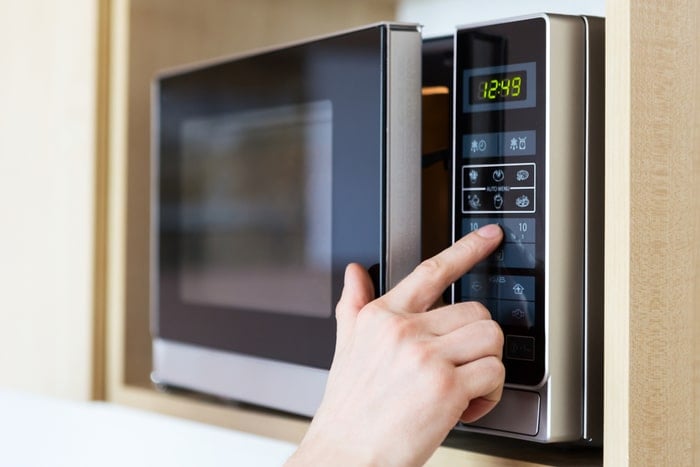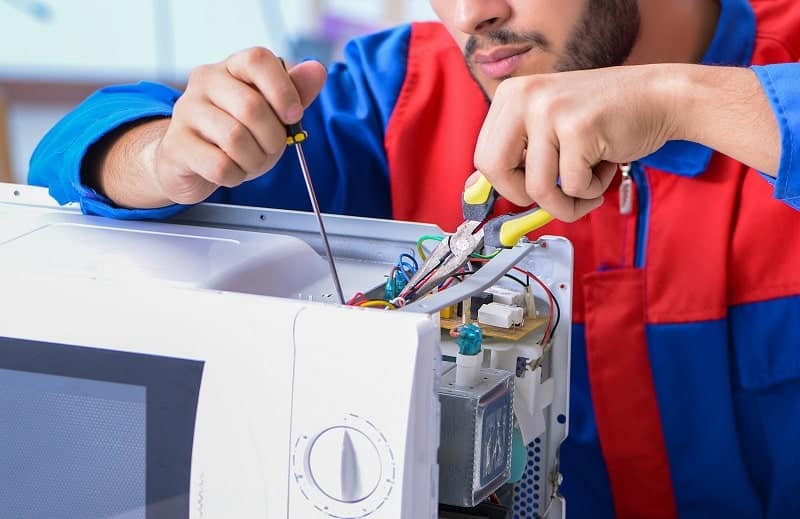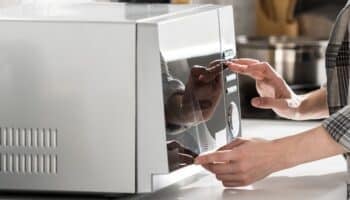We've independently reviewed this article to make sure it's as accurate as we can make it.
To find out more about our article creation and review process, check out our editorial guidelines.
Is your microwave defrost feature not working?
You’re not alone! I know how annoying it can be when your microwave stops working, especially when you’re hungry.
Luckily, with the help of this article, you’ll be able to fix your microwave.
If your microwave won’t defrost, chances are there’s an issue with the door switch, high-voltage section, or control board. Not using the correct power settings can also explain the problem.
Read on to get your microwave defrosting again!
Why trust us? This article was written by Craig Anderson and James Blackford.
Craig has helped thousands of other homeowners repair their appliances since 2016. James is one of our resident appliance experts with over 16 years of experience. He currently works as a Master Technician for SquareTrade, and runs his own appliance repair business.
Microwave Won’t Defrost Your Food? Try These 5 Fixes
Unfortunately, numerous reasons could explain why your microwave defrost setting is not working.
Luckily, there are 5 simple solutions you can try.
Before attempting any of the solutions mentioned in this article, unplug your microwave from the wall outlet and check the manufacturer’s manual.
If you’re not comfortable with repairing your microwave on your own, I highly recommend reaching out to a certified electrician.
#1 Check the Microwave Plug
I often tell homeowners to check the plug when a microwave defrost setting is not working.
You see, the plug can easily get disconnected and cause your microwave to refuse to work.
I recommend following the microwave cord as it comes out of the back of the microwave. Then, track the cord until it makes contact with the wall. Make sure it’s plugged in, and if there are any signs of damage, please replace the power cord.
If your microwave is not turning on or generating enough power to defrost your food, there’s a good chance the outlet is faulty. So, please use another device to test the outlet to ensure it works properly.
Don’t forget to take a look at the circuit breaker. If it has tripped, turn the switch back to the “On” position and try defrosting your food in the microwave again.
#2 Check the Defrost Settings
When I see a microwave that has power but refuses to defrost, I always take a closer look at the defrost settings.
Typically, the defrost setting uses about one-third of your microwave’s power. So, if it is not using enough power, the food will not defrost. On the other hand, if your microwave uses too much power, it will cook your food instead of defrosting it.
Some microwaves allow you to increase the power on the defrost setting to solve the problem.

Keep in mind that you do not want to increase the defrost setting too much. Otherwise, you could end up cooking your food instead of defrosting it.
Don’t forget to look at the food you are trying to defrost; please check if there is a recommended power setting. Then, set your microwave to that setting to ensure you defrost your food properly.
If the microwave is not changing power as you mess with the defrost setting, it could be a sign that there are other issues with the microwave. Fortunately, we are not done running through our possibilities just yet!
#3 Check the Door Switch
If your microwave still refuses to defrost your food, you’ll need to inspect the door switches.
The door switches are responsible for letting the microwave know the door has closed. So, if the door switches are not working, your microwave will mistakenly think that the door is still open when it’s closed. This issue will prevent your microwave from defrosting your food.
In my opinion, fixing the door switches is very simple.
The first thing you need to do is unplug your microwave and clean the door thoroughly. I recommend using a can of compressed air to remove food residue from the door switch. You can also use a cloth and a mild cleaning solution to wipe down the microwave.
If your microwave still refuses to defrost, remove the door switch to see if it is damaged and has to be replaced. Please use your manual to figure out where the door switch is located.
Replacement parts can usually be found on eBay or Amazon and cost $4 to $12.
If you want to get any replacement part – or see how much one would cost – click to enter your model number in the search bar below. Our partners at AppliancePartsPros stock almost every part with free guides on how to install them.

#4 Check the High-Voltage Section
I’ve found that in about 90% of cases, the culprit behind a malfunctioning microwave defrost setting is often related to an issue with the high-voltage circuit.

The most common indicator of a faulty magnetron, capacitor, or diode is when everything seems to be operating fine, but your microwave simply refuses to heat up or defrost your food.
In such cases, these components must be replaced by a certified electrician.
When dealing with issues with the high voltage section of your microwave, please reach out to a certified electrician.
You should never attempt DIY repairs on the High Voltage transformer, capacitor, or magnetron, as this can lead to electric shock, burns, or appliance damage.
Just keep in mind that the cost of repairing a microwave is usually higher than replacing it altogether.
So, please consider your microwave’s age and initial price, as it’s often more cost-effective to replace the entire unit.
#5 Check the Control Board
If your microwave defrost setting is still not working, I recommend checking the control board.
The control board is responsible for taking all the information from your microwave and distributing signals appropriately.
So, if there’s an issue with the control board, it can miscommunicate to your microwave that the defrost system is set to high, even when it is not.
You will need to take a closer look at your control board to see if it is working properly. Please read your manual to determine where it’s located; it’s typically underneath the keypad.
Unplug your microwave and test the individual components of the control board with a multimeter. Then, compare the reading to the ones recommended by the manufacturer.

Some control boards can be very expensive to replace. So, please consider the cost of your microwave and compare it to the repair cost.
If you want to get any replacement part – or see how much one would cost – click to enter your model number in the search bar below. Our partners at AppliancePartsPros stock almost every part with free guides on how to install them.

How Does the Defrost Feature Work?
Now you know how to fix a microwave that refuses to defrost food, but have you ever wondered how the defrost setting actually works?
Your microwave has multiple power settings that uses to figure out how much juice it should deliver to your food.
For example, if you have a standard microwave and are trying to heat your food, the default setting will use 100% of power to heat your food as quickly as possible.
On the other hand, there are some situations where you do not want your microwave to use all of its capacity. If you are trying to defrost your food, you want your microwave to do exactly that. You do not want your microwave to cook your food while it is still frozen. Otherwise, you could end up eating a hockey puck.
To ensure optimal results, microwaves typically use 30% of their power to defrost food.

Conclusion
Hopefully, now you’ll be able to solve the issue preventing your microwave from defrosting your food.
Remember, if your microwave won’t defrost, you’ll need to check the plug, door switches, control board, and high voltage section. It’s also important to make sure you’re using the correct power settings to defrost your food.
When dealing with issues with the high voltage section, don’t forget to contact a certified electrician. Don’t attempt DIY repairs.
Thank you so much for reading! If you found this article helpful, please check out our other free guides below.
Good luck!








